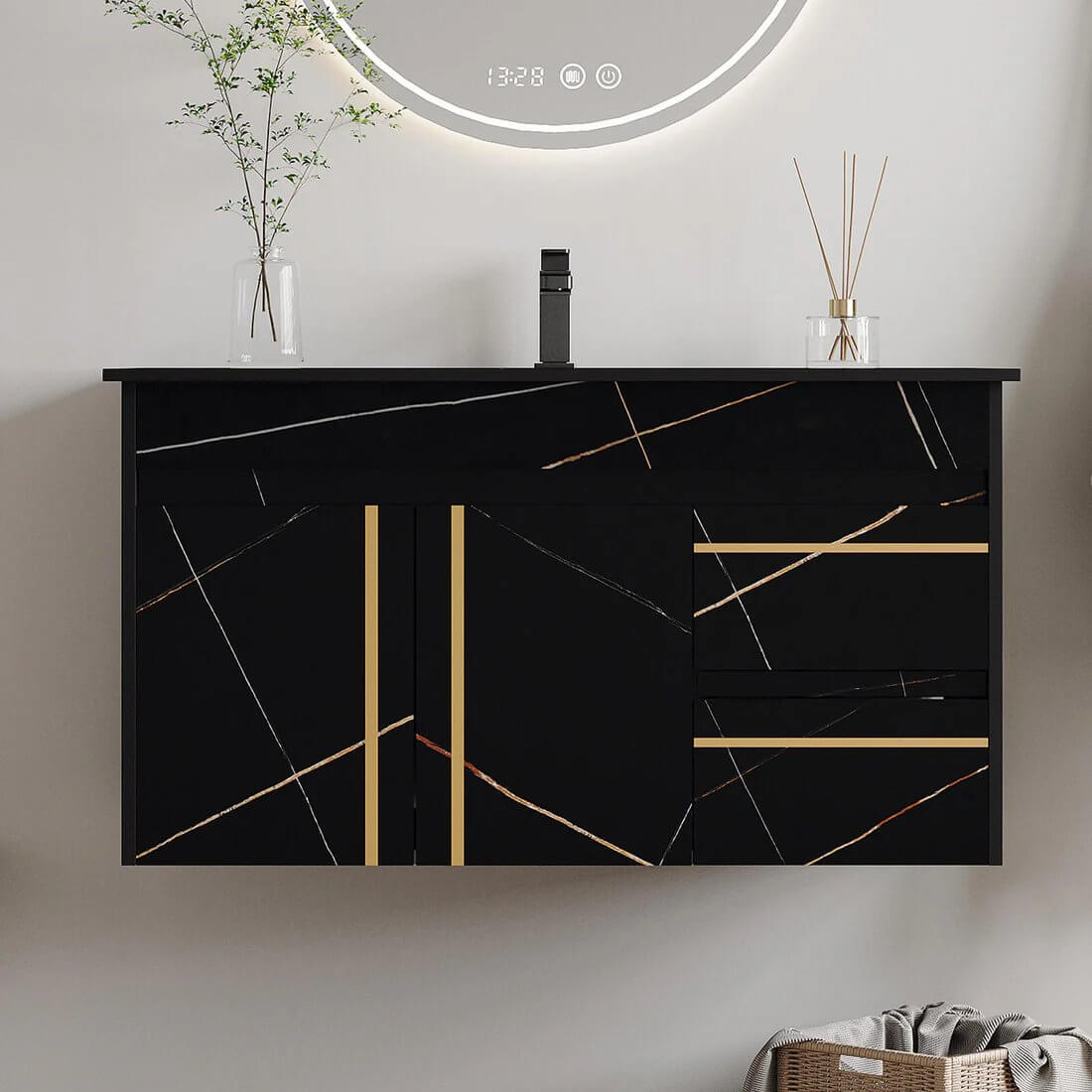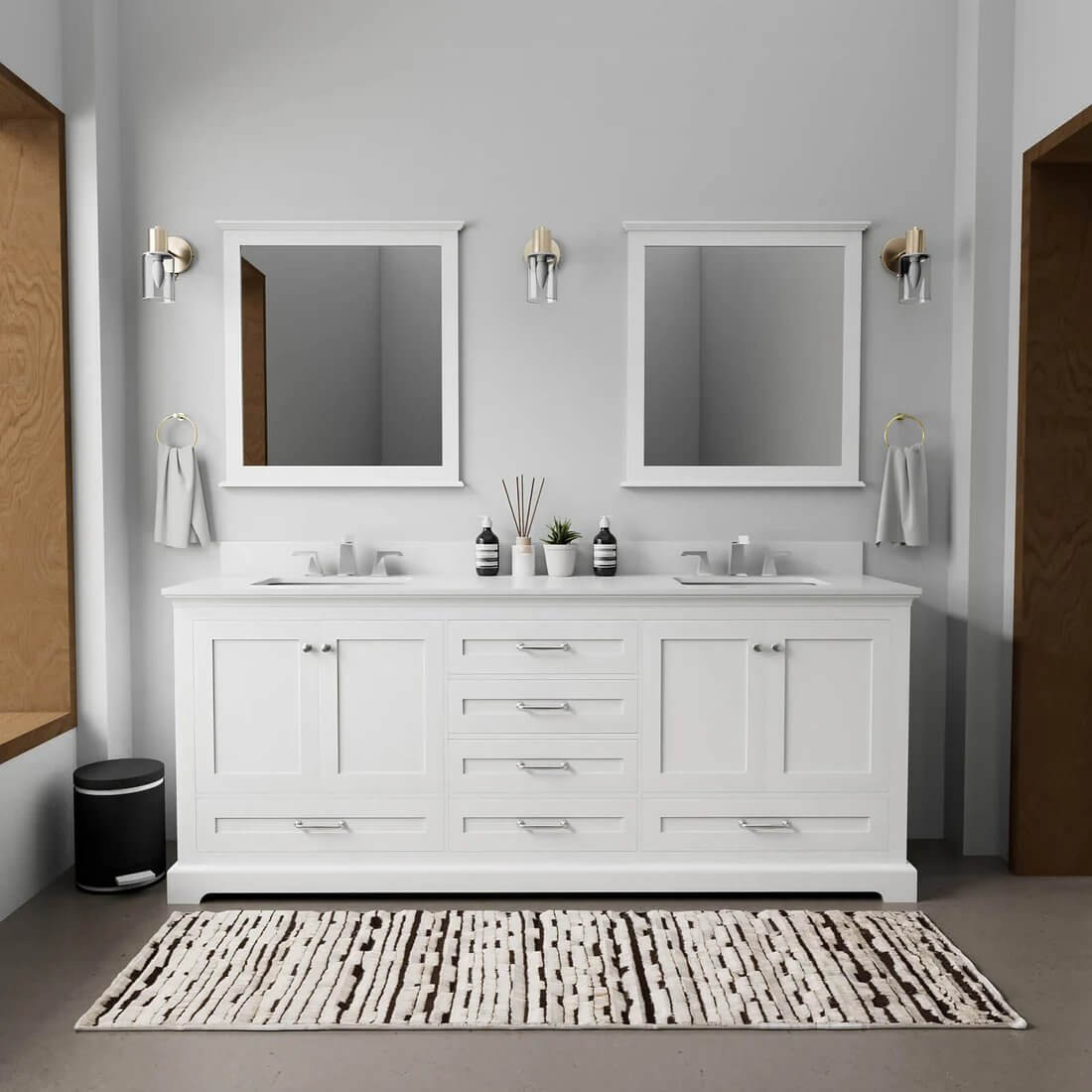When renovating a bathroom, choosing the right vanity is often more important than you might think. It not only impacts the convenience of daily routines but also determines the spatial efficiency and aesthetic of the entire room. Faced with two mainstream options—floating and freestanding vanities—many homeowners find themselves torn. Floating bathroom vanities exude a sleek, modern vibe, while freestanding ones offer timeless functionality. But which one suits your lifestyle better?

What Is a Floating Vanity
A floating vanity, also known as a wall-mounted vanity, is designed to be suspended from the wall without touching the floor, giving the bathroom a sleek, open, and airy appearance. This modern design is particularly popular in minimalist interiors, where maximizing floor space and enhancing visual openness are key. Supported by concealed metal brackets or reinforced mounts, the vanity remains stable while maintaining the illusion of "floating."
-
Advantages of Floating Vanities:
- Space-Enhancing: The open area beneath makes even small bathrooms appear more spacious.
- Easy to Clean: Mops and vacuums can easily reach the floor underneath, minimizing hygiene blind spots.
- Modern Aesthetics: Clean lines and minimal bulk make it compatible with contemporary décor.
- Customizable Height: Install at your preferred height for ergonomic comfort, especially useful for families of varying heights.
-
Disadvantages of Floating Vanities:
- High Installation Requirements: Must be mounted on load-bearing or specially reinforced walls, complicating construction.
- Limited Storage: Typically offer less storage than traditional cabinet-based vanities.
- Hard to Adjust Post-Installation: Once installed, changing the height or position is difficult.
- Maintenance Challenges: Plumbing repairs may require removing the countertop or accessing wall interiors.

What Is a Freestanding Vanity
A freestanding vanity, also known as a floor-standing vanity, is a bathroom cabinet that sits directly on the floor, with its base supporting the entire weight of the unit. This classic design is widely used in home bathrooms and is valued for its stability, easy installation, and generous storage capacity. It often features either integrated legs or a solid base and comes in a range of styles—from traditional to modern—to suit different interior aesthetics.
-
Advantages of Freestanding Vanities:
- Abundant Storage: Drawers and compartments make organizing toiletries easy.
- Flexible Installation: Doesn’t rely on wall structure—suitable for most bathroom layouts.
- Sturdy and Durable: Even weight distribution across the base ensures long-term stability.
- Easy Plumbing Access: Simply open the cabinet to service or inspect water lines.
-
Disadvantages of Freestanding Vanities:
- Occupies Floor Space: The base fully contacts the floor, limiting visual openness in small bathrooms.
- Tricky to Clean: Floor contact points can accumulate dust or moisture, creating hygiene issues.
- Fixed Height: Not easily adjustable to fit user preferences.
- Less Modern in Appearance: Often more traditional in design, which may clash with ultra-modern interiors.
Floating vs. Freestanding Vanity
| Comparison Item | Floating Vanity (Wall-Mounted) | Freestanding Vanity (Floor-Standing) |
|---|---|---|
| Style & Appearance | Modern and minimalist; creates a light, open feel | Traditional and solid; suits most standard bathrooms |
| Installation | Wall-mounted; requires reinforced wall support | Placed directly on the floor; simpler to install |
| Floor Clearance | No contact with the floor; easier to clean underneath | Touches the floor; more difficult to clean around base |
| Ergonomics | Height can be customized for user comfort | Fixed height; may not suit all users |
| Storage Capacity | Usually less space; may include drawers | More space for toiletries and essentials |
| Structural Stability | Relies on wall strength; professional installation needed | Stable on its own; supports heavier countertops |
| Plumbing Access | Often hidden in the wall; harder to reach | Inside the cabinet; easy to inspect and repair |
| Cleaning & Maintenance | Easier to mop or vacuum underneath | Requires bending or kneeling to clean around |
| Ideal Bathroom Size | Perfect for small or modern bathrooms | Great for medium to large traditional bathrooms |
| Overall Cost | Moderate to high, depending on wall prep | Budget-friendly; fewer installation requirements |
Which One Should You Choose?
Visual Impact: Floating Wins
If you want your bathroom to feel airy, spacious, and contemporary, floating vanities are the clear winner. Mounted off the ground, they create uninterrupted floor lines that visually expand even the smallest bathrooms. This is especially effective when paired with large-format tiles, LED under-lighting, or continuous flooring materials.
Freestanding vanities, on the other hand, add more visual "weight" to a space. While that can make a large bathroom feel grounded and cozy, in compact layouts it may contribute to a slightly crowded appearance—especially if the unit has a bulky base or ornate detailing.
Cleaning Convenience: Floating Wins
Because floating vanities’re elevated, there's no need to stoop or maneuver around corners to mop up hair, water, or dust. Robot vacuums glide under them effortlessly. In high-traffic bathrooms, especially those used by kids or pets, this small feature can lead to big long-term benefits.
Freestanding vanities sit flush with the floor or stand on legs, which often means narrow gaps where dirt and moisture accumulate. This makes them harder to maintain, especially in humid climates or bathrooms prone to spills.
Structural Compatibility: Freestanding Wins
Installing a floating vanity isn't just a matter of aesthetics—it requires structural readiness. These units must be securely fastened to studs or load-bearing walls, and sometimes you’ll need reinforcement or blocking behind drywall. If the wall can’t support the weight, installation becomes costly and complex.
Freestanding vanities, by contrast, are far more forgiving. They don’t depend on wall strength and can be installed in virtually any bathroom with a level floor. That makes them an excellent choice for older homes or remodels with uncertain wall conditions.
Design Versatility: Tie
Both vanity types are available in a broad range of finishes, materials, and styles. Floating vanities dominate the market for modern, minimalist looks, often with sleek lines, integrated lighting, and glossy finishes. They pair perfectly with vessel sinks, matte black fixtures, and wall-mounted faucets.
Freestanding vanities, meanwhile, offer unmatched range in traditional, transitional, and farmhouse styles. You’ll find options with turned legs, shaker doors, marble tops, and antique brass hardware. Whether you lean classic or contemporary, both options offer ample room to express your design taste.
Long-Term Maintenance: Freestanding Wins
When it comes to plumbing access, freestanding vanities offer a clear advantage. Most allow you to open a cabinet or drawer and get to the pipes without disrupting the wall or countertop. This is especially helpful during leak repairs, faucet replacements, or future upgrades.
Floating vanities often have concealed plumbing that runs behind the wall or through a narrow chase, meaning access can require removing panels—or even cutting into drywall. While this design is visually cleaner, it can increase the complexity and cost of maintenance later on.
Best for Small Bathrooms: Floating Wins
If you’re working with a tight footprint, floating vanities offer two important advantages: perceived space and physical clearance. They help avoid the “boxed in” feeling that sometimes comes with freestanding furniture, and they allow for more visible floor area, which tricks the eye into seeing more space.
That said, in very narrow bathrooms where storage is non-negotiable, a well-designed slimline freestanding vanity with drawers might offer a better balance of storage and function. The key is to prioritize your needs: openness or utility.
Ending
Choosing between a floating and freestanding vanity is more than a design decision—it’s a reflection of your lifestyle. Each choice represents your interpretation of what a "perfect home" feels like. There’s no absolute winner, only the right fit for your unique needs.
So ask yourself: Do you want a bathroom that feels airy and modern or one that’s grounded and organized? Do you prioritize fashion-forward design or everyday utility? As long as your chosen vanity enhances your daily life, whether floating or freestanding, you’ve made a worthwhile choice.
More Ideas
-

Vessel vs. Undermount Sinks: Which Fits Your Bathroom Best
When you’re updating a bathroom, the sink you choose does more than just hold water—it sets the tone for the entire space. The right style can elevate your vanity, influence...
-

Are Vessel Sinks Still in Style?
If you’re remodeling your bathroom in 2026, you might be wondering: are vessel sinks still in style? For many homeowners, this is a common question when deciding on a bathroom...
-

What Is a Vessel Sink?
If you’re tackling a bathroom renovation for the first time—or you’re simply dreaming up a vanity that feels a little more “you”—stepping into a bath showroom can feel like walking...
-

10 Bathroom Vessel Sink Ideas to Inspire Your DIY Vanity
When it comes to bathroom design, sinks often end up being treated as purely functional fixtures—useful, but not exactly inspiring. That’s why so many vanities end up looking alike: predictable...
-

How to Install a Vessel Sink in 4 Easy Steps
If the dimensional look and artistic appeal of a vessel sink have already captured your attention, then now is the perfect time to upgrade your bathroom with one. Whether you...
-

Vessel Sink Pros and Cons
In bathroom remodeling, the sink is one of the most frequently used fixtures, and your choice directly affects daily convenience and the overall look of the space. In recent years,...









